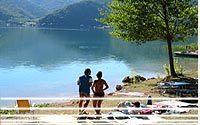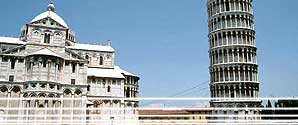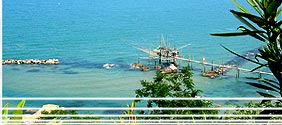 |
|
 |
City
of Pisa - Italy
| CITY
OF PISA
The city of Pisa is of Ligurian-Etruscan origin
but it was afterwards conquered by the Romans
thus becoming an important fortified town thanks
to its port. It extended its influence on eastern
lands too by taking part in the first Crusade.
Many enemies, above all Genoa and Florence, tried
to obscure the splendour of the city, so that
Pisa lost the control over the sea; however throughout
the centuries it became popular as a city of culture
and its good fame was confirmed by the foundation
of the Scuola Normale at the beginning of the
eighteenth century.
The beautiful Piazza dei Miracoli bears witness
to the city's glorious past and it is a place
visited by million of tourists from all over the
world.
|
 |
| |
|
- Duomo (Cathedral)
The Cathedral of Pisa is in romanesque
style. Buschetto started its construction
in the eleventh century but it was finished
in the second half of the twelfth century
by Rainaldo, who built the facade.
You can enter the Cathedral through four
doors: three of those doors date back
to the eighteenth century and have replaced
the original ones by Bonanno Pisano. The
door of St Ranieri is original.
Inside the Cathedral you can see many
works of art:
- the marble pulpit by Giovanni Pisano,
the basis of Italian gothic sculpture,
made between 1302 and 1311;
- the tomb of Emperor Arrigo VII,
made by Tino Camaino in the fourteenth
century;
-
the painting
with St Agnese by Andrea del Sarto;
-
the baroque chapel
devoted to St Ranieri,
i.e. the patron saint of the city.
|
|
 |
|
 |
|
(Torre di Pisa o Pendente)
Pisa, 10 mt |
 |
|
|
- Torre Pendente or Torre di Pisa
(The Leaning Tower)
Without any doubts it is the main tourist
attraction, well-known for its beautiful
design and unique in the world.
Bonanno Pisano started to build the tower
in 1173 but by midwork the tower leaned
because of a sinking of the ground. After
about a century Giovanni di Simone resumed
the building work: he solved the problem
thus becoming the main constructor of the
marvellous tower, even though the tower
was finished by Tommaso Pisano in 1372.
The tower is roud-planned and leans over
5° to the south. It has a winding staircase
made up of 294 steps. Through it you can
get to a panoramic terrace: from it Galileo
performed his experiments on the force of
gravity. |
|
 |
|
 |
|
(Battistaro - Baptistery)
Pisa, 10 mt |
 |
|
|
- Battistero (Baptistery)
Opposite the Cathedral's facade you can
see the Baptistery of St John the Baptist.
It was started by Diotisalvi in 1152 and
was finished by Nicola Pisano after about
a century. It is round-planned with octagonal-shaped
dome and arcades in the lower part; the
loggia shows sculptural decorations and
spires.
The Baptistery has four portals but the
one opposite the Cathedral is the most
beautiful because it is rich in XII-century
reliefs. Inside the Baptistery there are
a lot of sculptures by Nicola and Giovanni
Pisano, e.g. the beautiful pulpit by Nicola
Pisano.
|
|
 |
|
 |
|
(Palazzo dei Cavalieri
- Palace of Knights)
Pisa, 10 mt |
 |
|
|
- Palazzo dei Cavalieri
(Palace of Knights)
In the past Piazza dei Cavalieri was a
Roman forum and a medieval political place.
In that square you can visit Palazzo dei
Cavalieri, also called Palazzo della Carovana
because the aspiring knights attended
there an initiation course called "Carovana".
Palazzo degli Anziani del Popolo was changed
in its architecture by Vasari in 1562.
The facade's graffito decoration is original
though restored. Between the second and
third floor you can see niches with busts
of Medicean grand dukes.
|
|
|
|
|
 |
 |
| Beach
hotels |
| the most beautiful beaches
of Italy in the best hotels |
|
|
|


